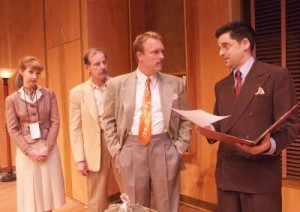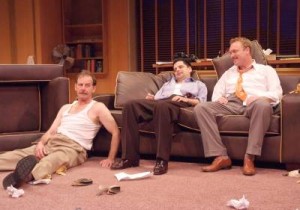
Hollywood legend has it that movie mogul David O. Selznick shut himself, director Victor Fleming, and script doctor Ben Hecht inside his office for five straight days, the three men subsisting entirely on a diet of bananas and peanuts, as Hecht rewrote the entire script of Gone With The Wind, a book he’d never read.
Playwright Ron Hutchinson imagines what might have happened behind those closed doors in his hit comedy Moonlight And Magnolias, now getting its first L.A./Orange County big stage production at the Laguna Playhouse (moving to the La Mirada Theatre For The Performing Arts in November). Blessed with Andrew Barnicle’s expert direction, sensational performances by Jeff Marlow (Selznick), Brendan Ford (Fleming), Leonard Kelly-Young (Hecht), and Emily Eiden (harried secretary Miss Poppenghul), and an absolutely gorgeous set designed by Bruce Goodrich, Moonlight And Magnolias is a show which will delight, entertain, and elucidate anyone who’s ever seen GWTW, and that’s just about everyone on the planet, right?
At lights up, Selznick has just shut down production on the movie, Sidney Howard’s script having proved unfilmable, and called in Hecht, screenwriter of Wuthering Heights, Nothing Sacred, Design For Living, and uncredited scribe of countless more movies in need of doctoring. The head of Selznick International Pictures has also fired director George Cukor and summoned Fleming to take over filming, despite the fact that Fleming still has two more weeks left on The Wizard Of Oz. Fleming, under contract to GWTW distributor MGM, has no choice but to acquiesce. Hecht, on the other hand, takes quite a bit more persuading—and $15,000 (about $225,000 today!) for his five days of work.
Since Hecht hardly has time to read the novel’s more than 1000 pages, Selznick has Fleming help him reenact the book’s key scenes, with the very macho Fleming portraying both Melanie and Prissy, and Hecht typing like a demon. As the hours and days pass, the men become more and more harried, the office gets messier and messier, and Miss Poppinghul’s hair takes on a life of its own. For audiences at the Laguna Playhouse, the result is some of the most hysterical physical comedy of the season, and a priceless lesson in Hollywood history.
In the 1930s it was common practice for screenwriters to change whatever they saw fit when adapting novels for the screen, and Hecht wants to change both the book’s setting and its time period (no Civil War movie ever having made money). Selznick, however, is adamant—Gone With The Wind will stick to Mitchell’s plot (and dialog), even if it means having an immoral hero and heroine and no romantic fadeout for Scarlett and Rhett. Then there’s the matter of the slap Scarlett gives to Prissy when the slave girl returns without a doctor in tow to the room where Melanie is about to give birth. Hecht imagines the slave girl giving an impassioned anti-slavery speech, and you can imagine how that would go off in 1930s America, especially in the still segregated South.
Besides the sheer entertainment value of Hutchinson’s script and the fly-on-the-wall sensation of being witness to Hollywood history, Moonlight And Magnolias also provides a glimpse of a time not quite so “golden” as social conservatives would have us believe. Not only “Negroes” are second-class citizens in 1930s Hollywood. Even Tinseltown’s uber-powerful studio heads find themselves unable to buy homes in upscale Hancock Park, nor can their bank accounts buy them memberships in the “best” country clubs, as Selznick finds out when Hecht telephones WASP producer Nunnally Johnson with a simple question, “David O. Selznick…American or Jew?” Guess what Johnson replies, as do the two other All-American power players Hecht phones?
Still, politics aside, Moonlight And Magnolias is mostly just great, entertaining fun, and some of the best acted fun you’ll see this or any month. The always marvelous Marlowe adds Selznick to the list of nebbishes he’s so masterful at embodying. Kelly-Young is perfection as the increasingly frazzled Hecht, and a master of the sarcastic retort to boot. Ford is a great, handsome, macho Fleming, his easy masculinity making his female impersonations all the funnier. Eiden makes the simple line “Yes, Mr. Selznick” worth its weight in gold. Rarely has an actress made so much out of so little to such hilarious effect.
Goodrich’s set is so elegant with its wood paneling, art deco wall engravings, and plush leather sofa and armchairs that it could have been transported directly from 1939 MGM to the Laguna Beach playhouse. Top marks too to Julie Keen’s period costumes, Paulie Jenkins lighting (especially for the way she lights the skyline seen through the office’s big picture windows), and Julie Ferrin’s sound design.
Having now seen Moonlight And Magnolias, I’m eager to get my hands on a Gone With The Wind DVD and re-experience one of the greatest films of all time. I know that from the opening notes of Max Steiner’s score to Scarlett’s “Tomorrow is another day!”, my viewing experience will be that much richer for having been inside Selznick’s office those five fateful days.
The Laguna Playhouse, 606 Laguna Canyon Road, Laguna Beach.
www.LagunaPlayhouse.com
–Steven Stanley
October 10, 2009
Photos: Ed Krieger




 Since 2007, Steven Stanley's StageSceneLA.com has spotlighted the best in Southern California theater via reviews, interviews, and its annual StageSceneLA Scenies.
Since 2007, Steven Stanley's StageSceneLA.com has spotlighted the best in Southern California theater via reviews, interviews, and its annual StageSceneLA Scenies.







 COPYRIGHT 2024 STEVEN STANLEY :: DESIGN BY
COPYRIGHT 2024 STEVEN STANLEY :: DESIGN BY